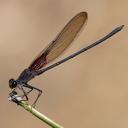United States and Canada
Males are large with an iridescent red head and thorax. The abdomen is iridescent green getting darker with age. The caudal appendages are pale and the wings have at least the basal fourth red, although the whole wing of teneral individuals may be amber. A pterostigma is present, but see discussion below. Females are largely iridescent green but with wing color duller than in males. The abdomen is pale laterally, including ovipositor. There is a pale narrow mid-dorsal line running the length of the abdomen.
Size: Total length: 36-51 mm; abdomen: 29-40 mm; hindwing: 24-31 mm
Similar Species: This southwestern species closely resembles American Rubyspot (H. americana), but it has a different abdominal pattern and lacks pterostigmas. See description of that species for futher distinctions. Smoky Rubyspot (H. titia ) has extensive brown in the wings and its range does not overlap with Canyon Rubyspot
Habitat: Wide, open streams and rivers.
Natural History: Males and females will perch horizontally on twigs and leaves of riparian vegetation, although females often perch higher. Sexes may also congregate near the water at night to roost. Numerous aspects of this species' distribution, behavior and ecology have been well studied. Although this is primarily a stream species, it has been shown experimentally that larvae and teneral adults exposed to still water returned to still water habitats after they had matured. There is extensive variability in this species. There are populations that lack a pterostigma, but these seem to be most abundant west of the Sierra Nevada Mountains in California and all individuals seen by the author in our region have had pterostigmas. Apterostigmatous individuals have been collected as far east as Grant and Lincoln counties, in southwestern New Mexico. An increase in the length of the basal red markings in the wings of males throughout the season has been recorded in three different Texas populations. Basal red markings of males collected in April range from 20-35% of the length of the wing. Males sampled at the same localities in September, however, had substantially larger red markings, ranging from 35-50% of the wing length.
Distribution: Throughout North America; south through Mexico, Guatemala and Honduras.
Source: Abbott, J.C. 2006-2010. OdonataCentral: An online resource for the distribution and identification of Odonata. Available at OdonataCentral.
Edited by Jake Zadik (8/28/2018).
